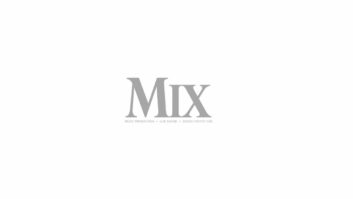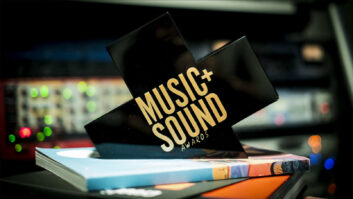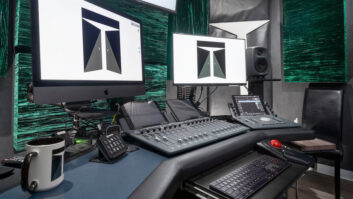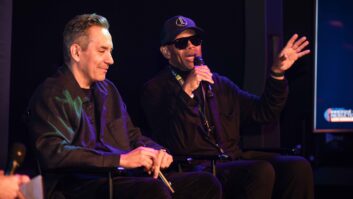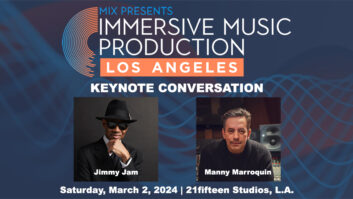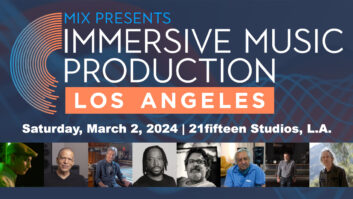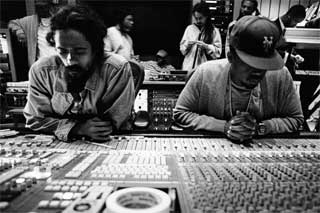
Damian Marley (left) and Nas in Henson Recording Studios (L.A.)
If you are surprised that Damian Marley—youngest son of reggae legend Bob Marley—would collaborate on an entire album with New York rap royalty Nas, then you probably haven’t been keeping up with the ever-shifting musical adventures of the many Marley siblings. While all of the Marley children who became musicians honor their late father’s legacy—incorporating his songs into their performances and frequently working together on various “family” projects and tours that inevitably draw on Bob Marley’s strong influence—they have also worked hard to carve out individual musical identities; none more so than Damian (aka, “Jr. Gong”), who was just two years old when his father died of cancer in 1981. On his groundbreaking and very successful 2005 album, Welcome to JamDistant Relativesrock, Damian Marley brilliantly fused hip-hop, dancehall, R&B and reggae in fascinating ways. That project was awarded two Grammys: Best Reggae Album (his second in that category) and Best Urban/Alternative Performance for the title song. That album also marked the first time Marley and Nas worked together (on the song “Road to Zion”), and that laid the groundwork for their eclectic new album as a duo, Distant Relatives.
And this truly is a collaboration: Both were involved in the writing of all 14 songs on the album, and each’s imprint is very strong throughout. That said, Marley, who produced all but two tracks that were helmed by his older brother Stephen Marley, had a greater hand in shaping the music on the album, and the core band—drummer Courtney Diedrick, bassist Shiah Core and keyboardist Phillip “Winter” James—is his. A number of high-profile guests also appear, including Stephen Marley, Somali rapper K’Naan, the ubiquitous Lil’ Wayne and veteran reggae singer (and occasional hip-hop collaborator) Junior Reid. Snippets of reggae pioneer Dennis Brown, who died in 1999, also appear prominently on a modern reworking of his classic tune “The Promised Land.”
There’s a strong social consciousness flowing through the raps on this album—Nas brings “street” with him wherever he goes, and Damian Marley, like all Marleys, is a committed advocate of the poor and the oppressed—but there is also a unifying concept to the project, Marley notes: “There’s an African theme throughout the album, whether it be lyrically or musically,” he says by phone from L.A., where the album was being mastered. “Some of the songs use samples from African music, and the riddims of some of the beats are reminiscent of African music, which was something new for Nas to rhyme over.”
Indeed, the first track Marley and Nas worked on (along with K’Naan) at Henson Studios in Hollywood was a tune called “Africa Must Wake Up.” At that point, Marley and Nas believed they were just working on an EP, but then over the course of the next year-plus, it developed into a full-blown album that was recorded at Henson and several studios in Miami (where Marley lives), including Hit Factory/Criteria, Circle House and the Marleys’ Lion’s Den studio. Tim Harkins (Korn, Spinal Tap) did the bulk of the engineering in L.A. and Hit Factory, while Marc Lee (Akon, The Game, Damian and Stephen Marley) handled most of the other Miami sessions. It was mixed at Circle House by longtime Marley family associate James “Bonzai” Caruso (Nas, Madonna, Mary J. Blige).

“When we started in [Henson Studio] D,” Harkins recalls, “I had them set up with the drums, and the bass was just a DI and then Winter, who’s the keyboard player, had a piano in the iso booth, and then a Rhodes, a clav and a Wurlitzer, and they’d loosely structure out these songs and go out there and do these jams for three or four hours. Winter would throw out these ideas, and if something would catch on like a chorus, they’d work on that idea for a while. We also had a percussionist, Leon [Mobley]. Then we’d go back and listen to the ideas and Damian would pick out which ones he thought might bear fruit. But he’d be in a booth, freestyle singing; he’d come up with a lot of the choruses right there on the spot. I would make a CD for Damian at the end of the night so he could listen to them overnight. There were so many ideas.
“Nas would usually come in later on in the second half of the day,” Harkins continues, “or there would be times he’d come in early and write to what was done the night before—he’d sort of sit there and go over ideas alone and with Damian.”
“Sometimes it might start with a hook and that would inspire somebody to do a verse or whatever the case may be,” Marley says. “There are some songs where he would do his verse first and his verse inspired my verses, or vice versa. But we did it together. It was all very natural, very organic. Musically, we went toward whatever anyone was gravitating toward. What Nas was loving, what I was loving—that’s where we went.”
“If there was a [musical] idea everyone liked,” says Harkins, “they would work it out more—doing tempo adjustments or whatever—and then go back and record it in a more finished structure.”
There were also songs, like kickoff track “As We Enter,” “that started with a sample of an Ethiopian musician and that is the majority of the beat on there,” Marley says. “Then I put drum machine drums on top of the sample, our bass player came in and put a line over the beat, then the keyboardist did the same and we built it that way.” There are songs that feature samples, loops, drum machine and live drums, and even one—“Dispear”—where Marley wanted the live drums to sound like a drum machine. In that case, Harkins says, “We did a lot of experimenting by cutting out the room mics for the drums and isolating and gating them to get it to sound like a drum machine. It was pretty cool because it made it like a nice engine that really propels the song. We went crazy on that song. There are horn overdubs, all sorts of things.”
The overdubbing process went on for many months, in L.A. and Miami, as the tracks grew to accommodate more musical ideas and experimentation. In fact, by the time the finished Pro Tools sessions were ready to be mixed by “Bonzai” Caruso on the SSL G Plus series at Circle House (after some initial work at Hit Factory), a couple of songs had accumulated more than 100 tracks—the most was around 140, for “The Strong Will Continue.” And how many did he end up with after he sorted through the mass of tracks? “Oh, about 138,” Caruso says with a laugh. “No, it was probably in the 120s. Sometimes I’ll consolidate things down or bounce down. On that session, I was probably using 70 to 80 faders. It was like a four-day mix.”
“It was insane,” Harkins comments of the plethora of tracks on several tunes. “There were a lot of vocals and a lot of tripling of things. They would get in there and get into these grooves and they’d ask me to keep adding tracks; we’d do this and we’d do that—‘Let’s try it.’ For some of the horn things, Damian brought in two players and it ended up being 12 tracks of just horns, and then there’s all kinds of stuff on top of that and lots of percussion, too.”
Keep in mind, too, that along with scads of natural instruments there’s also a healthy dose of hip-hop electronics, effects and atmospherics. Caruso notes, “It definitely has both the heaviness and the impact of the hip-hop realm and the feel and the timing of the reggae vibe, which comes down mostly to choices I make with delays—triplets and dotted delays as opposed to straight quarter notes and eighth-note delays. And all the great filtering effects that we use, too. I like the old analog delays. I use a lot of the old PCM 42s. But I’m also a huge fan of Echo Farm—I almost can’t do a mix without Echo Farm, which has one of the best analog-sounding filter-y delays. Sound Toys is another one I use a lot. Then there’s the old AMS delay and DMX, so it’s a blend of the old school and the new.”
“We tried to approach things track by track in a really organic way,” Marley says. “Whatever felt good and whatever sounded good. We didn’t sit there, and say, ‘Well, this is a hip-hop sound and this is a reggae sound.’ Old-school reggae—orthodox reggae—is a lot of live stuff, but with dancehall, and all that’s going on now it’s very much synthesized and programmed and all that stuff, so we were dealing with these different textures of sounds and different approaches in terms of recording.”

